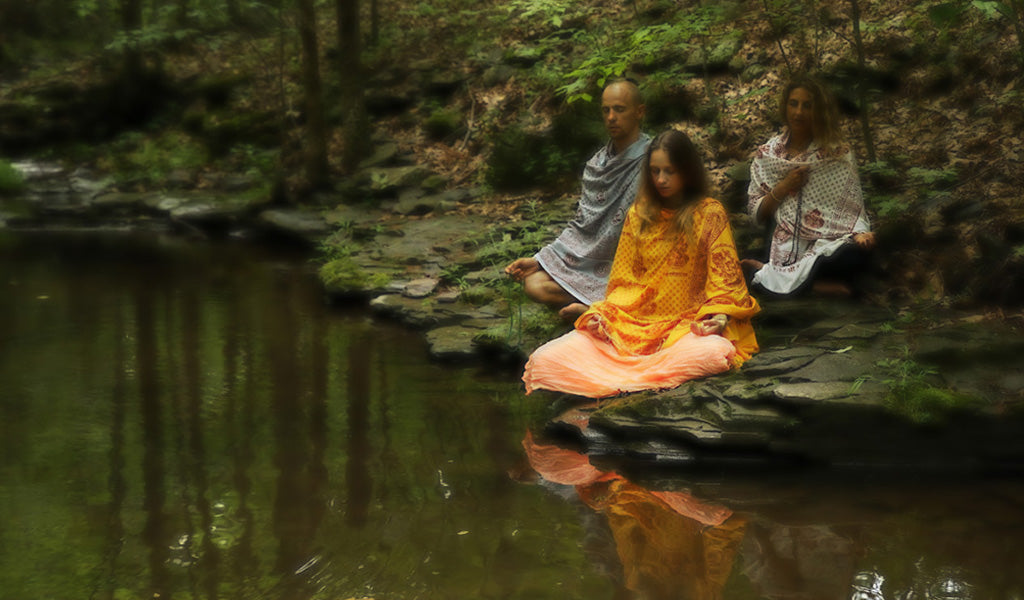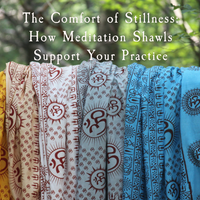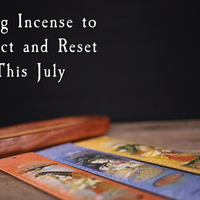If we were to tell you that you don’t need to do anything but we know of a way to enrich your life and get in touch with your soul, or at least taste the internal tranquility that awaits each one of us, you’d likely be waiting for the punchline and an inevitable fee.
So let us rephrase.
 There is a spiritual practice that enlightened beings have been inspiring seekers to do for thousands of years, and this involves doing nothing at all: meditation, the glorious state of no thoughts and no desires, but plenty of bliss.
There is a spiritual practice that enlightened beings have been inspiring seekers to do for thousands of years, and this involves doing nothing at all: meditation, the glorious state of no thoughts and no desires, but plenty of bliss.
But what is meditation?
“To meditate is to open the eyes of our soul and dare to look attentively and continuously.”~Prabhuji
“Whoa,” we hear you say. And we agree, it really is something quite amazing.
Prabhuji, whose full name is H. H. Bhaktivedanta Yogacharya Ramakrishnananda Swami Maharaja, has the grace to live in a constant state of meditation as a yogi hermit in the U.S., where he is entirely devoted to his spiritual life.
What Prabhuji described is what happens during meditation. He isn’t saying what it is, but rather what it is. It’s what happens when you are rather than when you do.
“The reason for its complexity and its difficulty lies in its simplicity, and in the fact that it requires no effort,” Prabhuji once said about meditation.
The Famous Yoga Sutras
Patanjali’s Yoga Sutras, ancient and highly regarded Hindu scriptures famous for describing the science of raja yoga, says meditation is “the uninterrupted flow of attention toward an object.”
But let’s take a step back for a moment and reflect on what mainstream knowledge tells us about meditation. It is “to engage in contemplation or reflection; to engage in mental exercise for the purpose of reaching a heightened level of spiritual awareness,” as Merriam Webster puts it.
Prabhuji speaks from the actual experience in the state of meditation—in the present moment where consciousness becomes conscious of itself—reminding us of a realm that is more real than anything else in this world that we only need to re-remember. And this does not involving doing anything, something that is not so easy for most people to (not) do.
“Meditating is not complicated, it requires no effort; it is much simpler than what is generally thought. However, what is simple may become extremely complicated when it is verbalized. ~Prabhuji
This is because the human mind cannot grasp what meditation is, because it is an experience that transcends the limits of time, space and causality.
Indeed, true meditation is difficult to grasp with words, but put simply it is “to observe what is, as it is, without making any effort, without judging and condemning, and without even reacting,” as Prabhuji has told his disciples many times.
“Wait a minute,” we hear you say, “Isn’t meditation something you do while sitting cross-legged with closed eyes?”
In short, the answer is yes. This is the physical posture that most people have while meditating but it is important to develop internal observation as a vital step toward decreasing your identification with your thoughts.
As this observation strengthens, we identify less and less with our mental activity, until it eventually ceases, allowing meditation to culminate in the total absence of thoughts.
Below are excerpts from some of Prabhuji’s writings on meditation that come from his very real experience in the elevated state. And if any of you are still wondering how to actually meditate without a technique, just let all the hows fall by the wayside, open your heart to the wisdom below, and allow whatever wants to happen, to happen.
Observation in Meditation
“To meditate is to observe the movement of the waves on the surface from the stillness at the depths of the ocean. In this state of alertness and clarity, the hidden and concealed within us is innocently revealed and exposed.”
“Meditation is to consciously establish oneself and rest in silence. To meditate is to observe the thoughts without thinking about them. It is to discover the mystery that lies concealed behind the words, in the hidden regions, in the source and origin of the thought, in that pre-mental, virgin and uninhabited region.”
“If we wish to allow meditation to happen, we must relinquish our accustomed roles as actors and doers, and adopt the perspective of a witness and observer, because meditation is the art of awareness, the art of attention, of observation.”
“When we speak of consciousness in this expanded state of perception, we are always referring to the consciousness of oneself, of the Self, of Reality. When we are conscious of something —regardless of who or what —it is always, in essence, the consciousness of what we really are, the infinite and all-pervading Self.”
Watchfulness in Meditation
“Meditation cannot be taught, as it is neither a method nor a technique, nor a physical, mental or emotional practice. Meditation does not consist in doing anything. Though it cannot be learned, dhyana (meditation) can be discovered in oneself, and solely by oneself, through attentive watchfulness. It does not arise as a result of study or learning, but blossoms from consciousness itself. To meditate is to place ourselves in the hands of God. It is to rest ourselves in the essence of what we are, since there is nothing we can do to be what we already are, always have been and always will be, the only thing we really can be.
“Meditation can neither be purchased nor acquired. If a method were capable of guaranteeing such a result, it would be more important than meditation, enlightenment, or God himself. Dhyana simply occurs, happens, takes place. All sadhana (spiritual practices), practice or techniques carry their own corresponding importance, but only as a preparatory step to create the appropriate situation for meditation to descend; never as a means of obtaining it. Just as with sleep, there is nothing we can do to make meditation happen, nor will meditation ever be the direct result of anything we do. We can buy a comfortable bed, disconnect the radio, draw the blinds, turn out the light, lie down and close our eyes, but we cannot make ourselves sleep. The simple fact of preparing the appropriate atmosphere provides no guarantee that we will be able to sleep. Sadhana consists in extending our limits to the maximum, to the farthest point. Only when we have done everything we can, will it become possible for meditation to descend upon us.”
“Whereas in concentration the mind focuses on an object, in meditation what is being observed is the mind; the observer becomes the observed.”
“Attention is the light of the soul that makes us aware of our actions, thoughts and emotions. In meditation, the meditator is the observed. In this way, we expand our awareness, directing our attention toward the observer, and regain consciousness of ourselves.”
Be Here and Now in Meditation
“Meditation is making contact with the present moment, it is to relate to what is happening now. Our fear of situating ourselves in the present is the main obstacle to meditation, since we dread finding ourselves thrust abruptly into a dimension filled with uncertainty and insecurity, in which we have no control over what is happening. For this reason we continue to reject the now by escaping from this moment.”
“All spiritual practice is an effort to create the ideal condition for enlightenment to occur. Our ability to establish ourselves in the present, in the now, is an essential part of this condition, since from the point of view of consciousness, this moment is the only real time there is. Or, from the point of view of the mind, it is atemporal. Meditation is to place ourselves in the now, the appropriate situation for consciousness to become conscious of itself.”
Accepting the Moment to Be in the Moment
“To accept the divine will is to accept each moment as it is, to accept the now and reality, life and existence as they are.”
“To accept the present moment is to lower our defenses, to stop protecting ourselves and allow the present moment to come close and happen within us, until we discover the now as the most essential and authentic in ourselves.”
“We will discover the present moment as our authentic nature, as what we really are, as our own self.”
“Judging and condemning this moment creates a conflict with what is happening: conflict between what is, and my rejection of what is, conflict between my interior and the exterior.”
“This conflict, when our thoughts, feelings, and emotions reject what is happening and resist what is, is a true obstacle for something of meditation to happen in us because this judging and condemning feeds our feelings of separation from the Whole.”
The Mind and Meditation
“We can transform the mind into a prison or into a door to freedom. The mind can either lead us magically to meditation, or it can lead us to insanity. It all depends on how we utilize our mind.”
There are five states of mind: agitated, confounded, restless, one-pointed and restricted. One-pointedness is called ekagrata in Sanskrit and is the ideal state to allow meditation to occur. As Prabhuji explains:
“In this state, the mind attains relative clarity and is able to focus on a single point without distraction. The mind acquires the power of concentration; that is to say, it has the capacity to remain focused on a single object. Nothing and no one can make it deviate from its aim. One who has reached this state has managed to create the fundamental favorable situation for meditation to occur, whereas without the development of the ekagrata, meditation is impossible.”
Tossing Out Desires in Meditation
“We should be content with ourselves and not wish for more than what we have. The problem lies not a lack of something, but in the fact that we have too many things covering us, so many that we cannot even see who or what we really are. This attitude of wishing for more than we have is a great obstacle in meditation because meditation is to watch and accept what is, as it is. If in meditation we clamor for more, desire and demand more, it will be our mind that will supply us with more dreams, illusions, and fantasies. God will never provide us with more, because he has already given us everything. We only have to pay attention and see how each moment brings within itself all that is necessary for our growth and evolution.”
“Don’t meditate to obtain tranquility or peace, or to become more creative. Don’t meditate to develop your intelligence, or to reach God or enlightenment, because these are not products or results, but only the natural consequence of a meditative life. Don’t meditate in-order-to or with the intention of receiving something or reaching some goal or ideal, however elevated and pure it may be. Any longing causes tension and becomes a serious obstacle to meditation.”
“Any expectation of obtaining something as a result or product of meditation directs us towards tomorrow, pulling us away from the present moment toward an illusory world.”
“Meditation is not a means through which we obtain some end, it is not a movement from here to reach somewhere else, it is not a path from yesterday to tomorrow. Rather, meditation is to transcend yesterday and tomorrow, here and there. To meditate is to leap outside of the concepts of space and time, to discover in the here, the infinite, and in the now, eternity.”
Discover Yourself in Meditation









0 comments